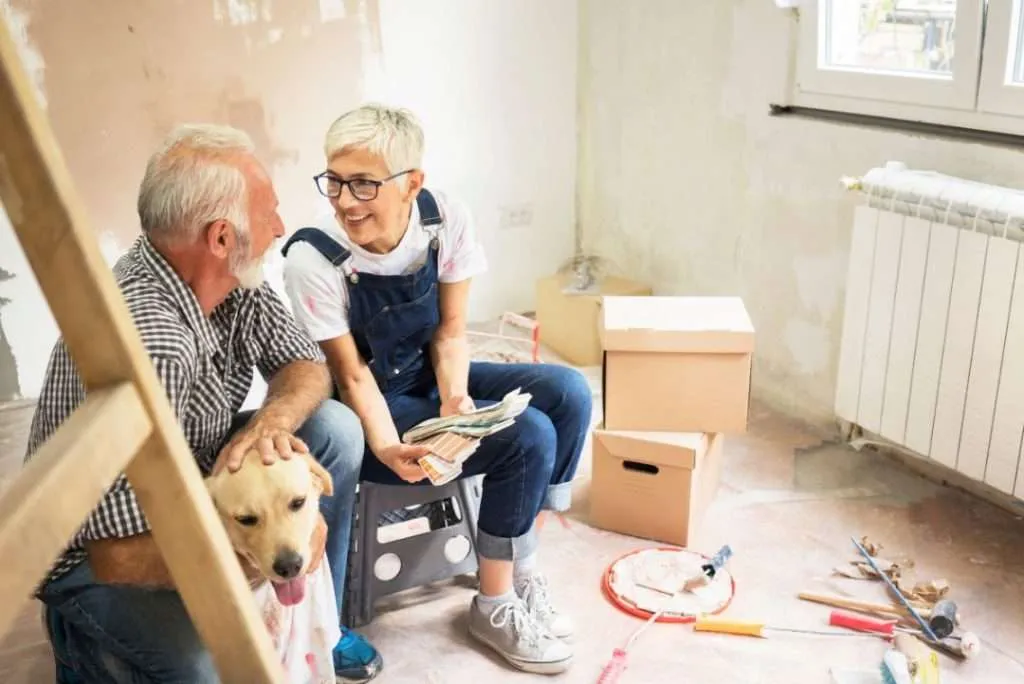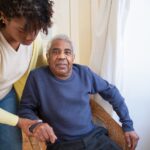“Aging in Place” is the ability to live independently, comfortably, and safely in your own home and community as you age.
The vast majority of older adults rate this as a top priority (over 88% according to the National Poll on Healthy Aging published by the University of Michigan in 2022). But your environment (home safety, accessible services) and personal circumstances (money, relationships, health) can make this challenging without some changes or support.
The good news is that with the right help you can live well in your own home and thrive.
After extensive research and interviews with independent older adults, we put together this resource to help you age in place vibrantly. Planning ahead now and making small changes, can help make this a reality.
Benefits to Aging in Place

Less Expensive
- Remaining in your own home eliminates moving expenses.
- Often, moving into a new home or community will require a significant down payment and a higher monthly payment.
- Assistance in the home is usually cheaper than residential healthcare. According to the World Health Organization, remaining in your own home as long as possible avoids spending a fortune on the costly option of institutional care.
Maintain Freedom and Sense of Identity
- Doing the daily activities of your life with no or minimal assistance reinforces your sense of independence. These are often easier to tackle in an environment that you are used to.
- Research in the Gerontologist demonstrates that aging in place “related to a sense of identity both through independence and autonomy and through caring relationships and roles in the places people live.”
Remain Connected to a Familiar Setting and Routine
- Continuing established routines strengthens familiar connections. It increases your feeling of comfort.
- In “The Meaning of “Aging in Place” to Older People” researchers also showed that aging in place was seen as an advantage because of a stronger sense of security and social support.
Challenges with Aging in Place

Getting around without incidents or anxiety
- Increasing difficulty walking, climbing stairs, or even driving can make it difficult to maintain your normal routines. Getting around the house can become a pain. And, running errands can sometimes seem like an impossible task.
- Isolation can become a challenge. Mobility issues may just make it hard to get out. Hearing and seeing problems might make you feel alone even in a group of people.
- Remaining connected to friends and activities can be tough. Some of your good friends may have passed or are not able to visit. Maybe you just don’t know what activities are going on that you would enjoy. And it can be difficult to make new friends.
Managing your home
- Sometimes your home may need some remodeling to make it easier to get around. Perhaps a bathroom needs to be added to the first floor. Or, you might need railings or ramps at some point to make your home more accessible. The hassle and costs of these modifications can add up.
- Home maintenance and upkeep can become challenging. Everything from cleaning to routine maintenance costs money or time that may not be available.
Safety concerns
- If you don’t have friends or family close by, an illness or home need becomes more of a concern. Having someone close by eases that anxiety.
- Crime and scams might also be a concern, especially if you live alone.
How to Age in Place Successfully

There are many things you can do, some simply and cheaply, to ensure that you are able to live in your home for as long as you choose. Here are some tips to get you started.
In-home care and services
Today many healthcare services that used to require a trip to the doctor’s office or hospital are available right in your own home. Many services are covered under Medicare. For more detailed information about Medicare coverage check out medicare.gov.
Home health care
- Home health care includes a wide range of care services that you can get in your home for an illness or injury. Examples include wound care, injections, and medication assistance.
- It is usually less expensive, more convenient, and just as effective as care you get in a hospital or a skilled nursing facility.
- Many services are covered under Medicare.
Telehealth
- Many insurance companies, including Medicare, now provide options to use telehealth. This can be done through a computer or even over the phone.
Personal care
- This is non-medical care, and often not covered by Medicare.
- This assistance helps with everyday activities like bathing and dressing, cooking, and light housekeeping.
Therapy
- Many therapies following an illness or injury are also available in your home.
- These services are often covered by Medicare.
Medical supplies
- Materials related to therapy or home health care are generally included by the provider.
- Other medical equipment, like wheelchairs or assistive devices, can be delivered to your home and are often covered by Medicare.
Meal preparation or delivery
- Senior centers or churches often provide free or low-costs meals for older adults. This is a great way to meet friends.
- There are also countless meal delivery options that bring great meals directly to your door. Meals on wheels is a free or low-cost option. Other services include UberEats and Grubhub for restaurant delivery or Home Chef and Blue Apron for delivered meal kits.
Money
Monthly bills can be a hassle. Not to mention how confusing healthcare bills are! Ask a friend or relative to lend a hand. There are also organizations that help with this. Check your local Area Agency on Aging for assistance.
Be careful not to give your personal information (credit card numbers, social security number, bank accounts, etc.) to anyone that asks for them by mail, email, or phone. There are many scams that try to act like your own bank or government agency. If you are unsure, contact your local police department. They generally have a detective that works specifically on scams.
Transportation
One of the biggest hurdles you may face is just getting around town. When it becomes a problem to drive yourself, there are many helpful solutions out there.
Friends and family are an excellent resource if they are available. If that doesn’t work, you can contact your local Agency on Aging for resources in your town.
Many towns and cities offer free or reduced public transportation for seniors. Some of them even have point to point individualized transport, and accessible vehicles.
Another option is to use ride-sharing services, such as Uber and Lyft. Both have specific programs that include extra assistance for those in need. Uber Assist certifies drivers to give special assistance to riders who may need extra help. Lyft Assisted pairs you with a driver that can meet you at the door, carry light items for you, and help you get in and out of the vehicle.
Other services like Go Go Grandparent and Common Courtesy make it a breeze to use rideshare programs even without a computer or smartphone. They utilize Uber, DoorDash, Instacart and others, to coordinate rides, meal, grocery, and prescription delivery over the phone.
The National Volunteer Transportation Center promotes and helps coordinate volunteer transportation. They do not provide transport themselves, but seek to fill in some of the gaps left by other services. The center has a large database, and a map of volunteer driver programs in all 50 states.
Home modifications
As you age your home may have a few areas that hamper mobility or create risks for falling. Some of these areas require simple fixes to make them safe. Others may require more work or hiring someone to make modifications. Here are some examples of both to consider.
Simple home fixes
- Make sure your lighting is bright enough, especially in areas where you walk. And, ensure light switches are easy to reach and convenient.
- Declutter areas where you walk, especially high-traffic areas.
- Use anti-slip mats in bathrooms or other areas with hard-surface floors.
- Place books, objects, food, and other everyday items on shelves or cabinets that are easily accessible and do not require you to stretch or use a stool.
- Add handrails or grab bars to hallways and bathrooms to help avoid falls.
- Replace any furniture that is not steady or secure.
- Install knobs on cabinets, windows, and doors that are easy to turn or handle, even if you are developing arthritis.
Home modifications
- Bathroom – Install grab bars in the shower or tub for getting in and out easily. You may also want to replace a tub with a walk-in shower or tub for accessibility. And taller toilets make it easier to get up and down.
- Ramps – Putting in a ramp to an outside door can significantly help when entering or exiting the home. Even if you are still walking well, a gradual incline with handrails make home entry safer and more comfortable.
Granny pods
- A granny pod (aka Accessory Dwelling Unit – ADU) is a modified guest house that allows you to live in close proximity to loved ones.
- If your children or other loved ones have a big backyard they can install a small guest house that is adapted to fit your personal needs.
- Granny pods can be affordable, close to assistance, and still allow you to be independent.
Technology
Technology has come a long way toward helping older adults to remain in their homes longer and continue to be independent. Everything from emergency assistance to your favorite music to everyday reminders is now at the touch of a button or the sound of your voice. Here are a few technologies to consider using.
Smart home
A smart home includes appliances, tools, and technology that is connected to the internet. These items can make your life simpler and more convenient by doing some of your daily tasks for you.
- High-speed internet is key to making a smart home work well.
- An easy-to-use computer can be a real help as well. Our favorite easy-to-use computers are here.
- Consider getting voice-activated speakers such as Alexa, Google Nest, or Apple Pods. These can connect to your TV, thermostat, music speakers, lights, and more to make all of these devices usable with just your voice.
- Smart thermostats allow you to set daily and hourly schedules for your heating and cooling. This can be energy efficient and more pleasant.
- Smart doorbells allow you to see who is at the door, if a package was delivered, or let someone in the house without getting up.
- Smart light bulbs allow you to set schedules or turn them on and off by voice.
Medication assistance devices
Medication assistance devices range from simple reminders to automated dispensers that make sure you take the right medications in the correct doses each and every time. The Senior List has a great guide to the best medication dispensers out there.
Personal Emergency Response System (PERS)
A PERS is vital if you are at risk of falling or having a health crisis. It can be a lifeline to quick response.
- Systems range from wearable devices like a neck pendant or watch to mounted buttons and motion sensors.
- When activated, most systems will communicate directly with you and send the right help if it is needed.
- These systems generally charge an installation fee and monthly monitoring fee, and are not covered by most insurances or Medicare.
Wearables
Wearables, like PERS, can monitor health vitals and notify you if something is wrong. Examples include smart watches, smart rings, or other activity trackers. Apple watches, for instance, monitor your heart with a built-in ECG and can alert you if there are irregularities, or your heart rate is too high or low.
Resources for Aging in Place

Here are some of the best resources for more information on aging in place.
- Start with people you know. Friends, family, community groups, and churches all have information or programs to help.
- Area Agencies on Aging – To find the closest one to you enter your zipcode in this excellent government locator tool.
- National Aging in Place Council. This organization is a senior support network that connects service providers with elderly homeowners, their families, and caretakers. Check out their website (ageinplace.org) for more information.
- Village to Village Network. This national nonprofit leverages neighbors helping neighbors to help you age well in your own home and community. Find a village close to you on their website: https://www.vtvnetwork.org/
- Program of All-Inclusive Care for the Elderly (PACE) is a program run by Medicare and Medicaid. It covers in-home care, adult day care, doctor visits, hospital and nursing home stays, prescription drugs and some medical transportation. Many services are covered, but there may be a monthly charge for some services. Find a program near you online at PACEFinder or call 1-877-267-2323.
- The National Council on Aging has many resources to help you at home. Their Benefits Checkup will connect you with programs that can help pay for health care, medicine, food, utilities, and more. Just enter your zip code.
- More government and educational information sites:
- Eldercare Locator
- 800-677-1116
- [email protected]
- https://eldercare.acl.gov
- Eldercare Locator
- Centers for Medicare & Medicaid Services
- 800-633-4227
- 877-486-2048 (TTY)
- https://www.cms.gov
- www.medicare.gov
- USAging
- 202-872-0888
- [email protected]
- www.usaging.org
- Department of Housing and Urban Development
- 202-708-1112
- 202-708-1455 (TTY)
- https://www.hud.gov/
- Low Income Home Energy Assistance Program
- 866-674-6327
- [email protected]
- https://liheapch.acf.hhs.gov/help
- National Resource Center on Supportive Housing and Home Modifications
- 213-740-1364
- [email protected]
- www.homemods.org






